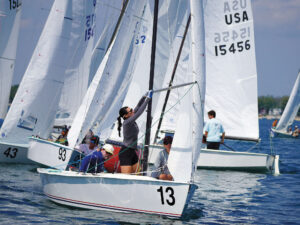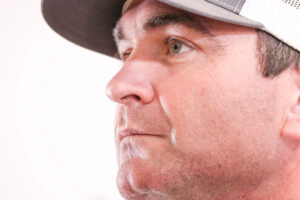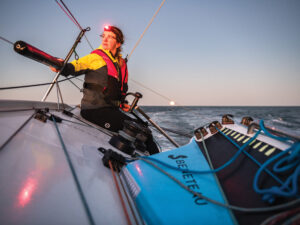
Volvo Ocean Race Route
Prelude to the Volvo Ocean Race In a recent team update, Bouwe Bekking, skipper of the Spanish Volvo Ocean Race entry, Movistar, said that with six of seven teams now in Sanxenxo, Spain, he’s starting to “taste the race atmosphere.” He’s not the only one. As the start-day countdown finally dropped into its final two weeks, boat measurements are wrapping up, crews are getting their final physical exams (so they can gauge what toll the race takes on their bodies), sails are getting re-cut, freeze-dried provisions are getting sorted out, and tacticians are planning how to get through the first in-port race without losing too much face, and without breaking boats or body parts. A virtual three-ring circus is now underway in Sanxenxo (I’m told it’s pronounced “San-chen-cho”) where all except the Australian-flagged Premiere Challenge, now have their bases in full pre-race high gear. Sanxenxo, a tourist town on the northwest coast of Spain, is north of the actual start port of Vigo, and it’s here where only one in-port race will take place-we’re told in close proximity to shore. The race is expected to be a 30-mile Olympic-type (combination of upwind, reaching, and downwind). The race will go down mid-day on November 5, and after that the boats remain in Sanxenxo while race fans, media, and curious Galicians take in the Volvo port experience. To keep the audience’s attention, five Volvo Extreme 40 catamarans, which are described as oversized Tornado catamarans, will be racing mornings and afternoons, taking media and VIPs along for thrill-rides. On Nov. 11 the fleet moves down the coast to Vigo for the big send off on Nov. 12. Then, it’s onwards toward Cape Town and the race’s longest leg. With a completely new boat design, and so few under-the-hood details known among them, a top-to-bottom ranking at this point would be pure speculation, but Team Movistar is getting a lot of early attention because of the time it has spent on the water learning its boat-the 24-hour record it has in its back pocket is a bonus. Plus, they picked up two of illbruck’s best guys in Richard Clarke and Stu Bannatyne. Team Ericsson Racing, led by Neal McDonald, is another high favorite, taking into account the experience and record of its crew, as well as the team’s get-the-weight-in-the-bulb boatbuilder Jason Carrington. The true dark horse of the fleet is ABN AMRO’s A team; its Juan Kouyoumdjian-designed 70 is noticeably different than the other Farr Yacht Designs, and over time they’ve hinted that they have a few tricks up their sleeves (something in the sail inventory, perhaps?). Don’t forget that they have top-shelf navigator Stan Honey, and Mark Christensen, the best watch captain in the business, and the benefit of two-boat testing. AMRO’s B team, while still young and evergreen, hopes to “surprise a few people” in Cape Town, and they very well could-stranger things have happened in the race’s opening leg. Brazil 1, led by Star class Olympian Torben Grael, has so many unknowns, especially in its crew list, which has added new faces in the last few weeks. They’ve signed on Knut Frostad, who has done the race as much as or more than anyone in the fleet (last time leading Djuice Dragons). Problem is Frostad can never seem to shake that dark cloud overhead. Grant Wharington’s Premiere Challenge, which in last month has scuttled its pro crew in favor a pickup squad yet to be finalized, is citing a serious lack of funds and will sail the race leg by leg-certainly not a winning strategy. And then there are Paul Cayard’s Disney Pirates-a boatload of veterans intent on climbing the VO70 learning curve by the time they reach the back nine. No one is discounting them, and with the high speeds these boats are capable of, the way to stay in the hunt is, obviously, to stay in one piece. Serious breakdowns will cause weather-system-sized gaps and there’s no green flag on this racetrack. I’ll be reporting in from Sanxenxo throughout the lead up to and after the start, so check this space regularly.









